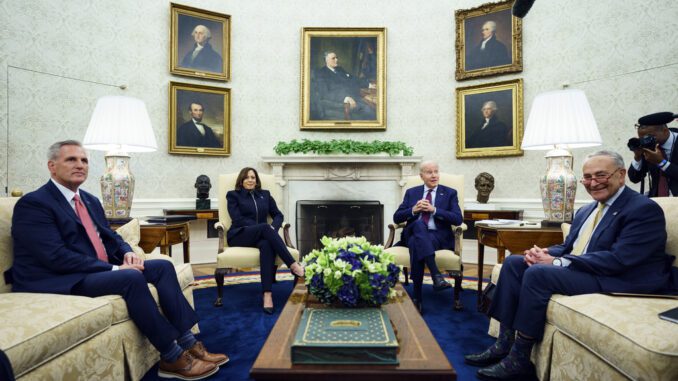
If there ever was a completely avoidable, contrived political issue, the debt ceiling is it.
If Americans had elected a majority of deficit hawks instead of debt doves to Congress and the White House and kept balancing budgets since 2001, there would be zero federal debt today. No debt means no interest costs. No interest cost means no threat of “default” or bankruptcy.
$600 billion in interest expense could be saved this year alone.
As long as the federal government pays the full amount of interest on the national debt to all debtholders each month, there will not be any actual or technical “default” on our debt no matter what the breathless news anchors try to tell you.
During World War I, Congress passed the Second Liberty Bond Act to put the brakes on excessive borrowing. Members of Congress used to realize the dangers of excessive debt and interest charges, something which appears to have been lost on most representatives, senators and presidents from both parties for the past 20 years.
A bipartisan pox on all their houses. Voters bear their share of responsibility for continuing to vote for such fiscally challenged people to represent them in government.
The most logical, rational, adult way to resolve this so-called “crisis” is for Congress to pass a budget that falls back to the levels of spending projected by the Congressional Budget Office in 2020 before the pandemic. With a short-term debt ceiling hike, we could balance the budget within the next five years simply by going back to a lower expected growth in spending baseline.
Barring such a mature, common-sense compromise solution, Republicans should hold firm and not pass a debt ceiling extension. Call the bluff of President Joe Biden and Senate Democrats. Make them prioritize federal spending based on the amount of tax dollars flowing to the U.S. Treasury on a monthly basis without recourse to more borrowing.
The markets might reward such courage and leadership with a rebound of biblical proportions.
In 2022, taxpayers paid a record $5 trillion to the IRS. However, the federal government spent $6 trillion, which meant it had to borrow $1 trillion from somewhere to pay the bills.
Apologizing in advance for the numbers to follow, here’s how President Biden, as chief executive under the powers vested in his office by the Budget and Impoundment Control Act of 1974, might decide which programs to fund with $5 trillion of cash tax revenue and at what level.
Interest on the debt has to be paid in full ― period. Interest on debt is always paid first in any financial situation. Interest costs will be $640 billion this year. Subtract $640 billion from $5 trillion of incoming cash tax money ― $4.36 trillion will be left to spend on everything else.
What has to be paid next in order to prevent massive political turmoil? Senior citizens benefits — seniors vote in every primary, special or general election, while people aged 18-34 show up in large numbers only in presidential years. Seniors are not usually associated with fiery, violent demonstrations downtown, but they will erupt at the ballot box if Congress cuts any part of the $1.14 trillion spent on Social Security this year.
$4.36 trillion minus $1.14T trillion leaves $3.22 trillion to pay for everything else.
Next up in terms of prioritization will be all federal health care programs, Medicare/Medicaid, CHIP and ACA which cost $1.4 trillion annually: $3.22 trillion less $1.4 trillion equals $1.82 trillion left to pay for everything else.
National defense in all forms, including veterans’ benefits, clocks in at about $1 trillion annually. We have to defend our borders and interests (oil, democracy and free trade overseas) and take care of our vets, don’t we?
$1.82 trillion less $1 trillion leaves $820 billion to pay for everything else.
“Everything else” means all discretionary programs such as housing, welfare, education, environmental protection, energy and NASA, plus inane wasteful projects such as the Bridge to Nowhere and the Steamtown Museum celebrating steam locomotives in the Poconos.
Discretionary programs account for $1.7 trillion in spending. Simple math shows every nonmandatory, noninterest, nondefense program would have to be cut at least 50% if the federal government had to operate solely on cash coming in the door in taxes.
We have just lived through two years of government shutdown of many services. Maybe we could do it again.
Otherwise, every program, including all entitlements, would have to be cut at least 20% in order to match up expenses with incoming tax revenues.
We all knew the day of reckoning would arrive one day. Today is just the beginning.


